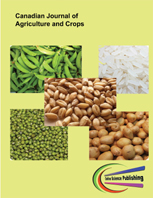Synergistic Effect of Poultry Manure and Some Botanicals on Cowpea Root-Gall Nematode Infection in a Naturally Infested Soil of Owerri, Imo State, Nigeria
DOI:
https://doi.org/10.20448/803.4.1.17.25Keywords:
Cowpea, Botanicals, Galling index, Neem leaves, Nematode population, root-gall nematode.Abstract
This study was carried out at the Postgraduate Teaching and Research Farm of the Federal University of Technology Owerri in 2017 cropping season to ascertain the synergistic effect of poultry manure and some botanicals on root-gall nematode infection on cowpea in a naturally infested soil. The experiment was laid out in a 2 x 3 factorial in randomized complete block design with four replications. The factors whose effects were investigated included: cowpea varieties (Ife brown and Oloto brown) and organic soil amendments (poultry + siam weed, poultry + neem leaves and control). Data were collected on nematode population in the soil, galling index using scoring scale of 0 - 4, number of leaves, plant height, peduncle length, number of pod, pod length, fresh pod weight. Results revealed significant effect (P < 0.05) of the combination of poultry manure and neem leaves which recorded the lowest nematode populations (464, 369 and 289) larvae/ 200 g soil at 30, 60 and 90 days respectively when compared with the control. However, Ife brown variety planted on plots with the mixture recorded the highest growth and yield attributes with reduced nematode infection when compared with Oloto brown on plots with mixture of poultry manure and siam weed and also the control plots. Consequently for increased grain yield, Ife brown cowpea variety susceptible to root-gall nematode (Meloidogyne incognita) can be planted in an infested soil amended with the mixture of poultry manure and neem leaves for effective control of root-gall nematode.


